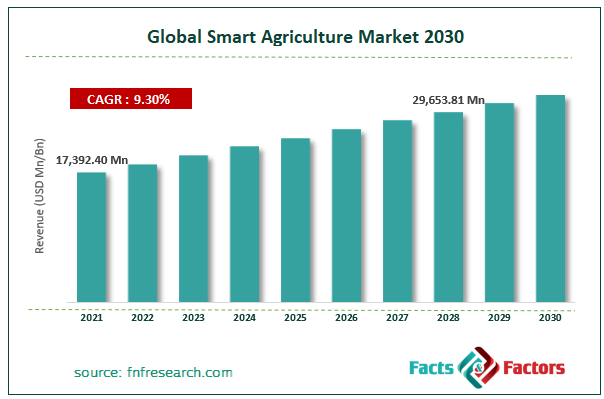Search Market Research Report
Smart Agriculture Market Size, Share Global Analysis Report, 2022 – 2028

Smart Agriculture Market Size, Share, Growth Analysis Report By Type (Precision Farming, Livestock Monitoring, Precision Aquaculture, Precision Forestry, Smart Greenhouse, and Others), By Offering (Hardware, Software, and Services), By Application (Irrigation Management, Yield Management, Crop Scouting, Field Mapping, Weather Tracking & Forecasting, Inventory Management, and Farm Labor Management), and By Region - Global and Regional Industry Insights, Overview, Comprehensive Analysis, Trends, Statistical Research, Market Intelligence, Historical Data and Forecast 2022 – 2028
Industry Insights
[232+ Pages Report] According to the report published by Facts & Factors, the global smart agriculture market size was worth USD 17,392.40 million in 2021 and is estimated to grow to USD 29,653.81 million by 2028, with a compound annual growth rate (CAGR) of approximately 9.30% over the forecast period. The report analyzes the smart agriculture market's drivers, restraints/challenges, and their effect on the demands during the projection period. In addition, the report explores emerging opportunities in the smart agriculture market.

 Market Overview
Market Overview
An integrated management strategy used to boost the agricultural sector is called "smart agriculture." It uses various cutting-edge technologies, including big data, cloud-based services, and the Internet of Things (IoT). In addition, optimization satellites, telecommunication, platforms, GPS, sensors, and wide area networks are used in smart agriculture for data analytics, field mapping, irrigation control, weather monitoring, soil scanning with sensors, and labor management. To improve total crop yields, farmers can use these tools to harvest crops, manage inventories, and buy necessary supplies. The growing acceptance of the technology across various applications, including precision farming, smart greenhouses, aquaculture, and animal monitoring to ensure minimal manual intervention, is one of the key drivers of the growth of the smart agriculture market.
 COVID-19 Impact:
COVID-19 Impact:
During the ongoing COVID-19 outbreak, savvy agricultural market actors have been moving at breakneck speed to supply the enormous demand for high-quality food goods. Participants in the smart agriculture sector have come under intense examination for contactless equipment management and other practices due to rising awareness of food safety requirements.
 Key Insights
Key Insights
- As per the analysis shared by our research team, the global smart agriculture market value is expected to grow at a CAGR of 9.30% over the forecast period.
- In terms of revenue, the global smart agriculture market size was valued at USD 17,392.40 million in 2021 and is projected to reach USD 29,653.81 million by 2028.
- The growing acceptance of the technology across various applications, including precision farming, smart greenhouses, aquaculture, and animal monitoring to ensure minimal manual intervention, is one of the key drivers of the growth of the smart agriculture market.
- By type, the livestock monitoring category dominated the market in 2021.
- By application, the irrigation management category dominated the market in 2021.
- North America dominated the global smart agriculture market in 2021.
 Growth Drivers
Growth Drivers
- The use of modern technologies in agricultural products drives the market growth
One of the key factors propelling the growth of the global smart agriculture market is the incorporation of contemporary technologies such as variable rate technology (VRT), data management software, mapping software, yield mapping software, and GPS in agricultural products. These innovations increase productivity & profitability, lower costs, and support sustainable agriculture. They also increase land fertility. The market's expansion is accelerated by the availability of numerous sensors, including vibration, temperature, and load. The semiconductor industry's ongoing technological developments and the fierce competition among manufacturers also contribute to the market's expansion. Additionally, the market for smart agriculture is positively impacted by rising urbanization, lifestyle change, agricultural sector expansion, the spike in investments, and the expansion of government programs.
 Restraints
Restraints
- The high cost of development of modern agricultural equipment may hinder the market growth
Market expansion is anticipated to be hampered by the high development costs of modern agricultural equipment and the fragmented agriculture sector. Additionally, the administration of massive amounts of data for effective decision-making and environmental concerns is anticipated to provide challenges to the market for smart agriculture throughout the anticipated period.
 Segmentation Analysis
Segmentation Analysis
The global smart agriculture market has been segmented into type, offering, application, and region.
Based on the type, the smart agriculture market is segregated into precision farming, livestock monitoring, precision aquaculture, precision forestry, smart greenhouse, and others. Among these, the livestock monitoring segment led the market in 2021 and is expected to maintain its dominance throughout the forecast period. The market players have been recommended to concentrate on new product launches and significant cost savings related to livestock monitoring management due to factors including the expanding size of dairy farms and rising technical breakthroughs, such as precision livestock monitoring.
Based on the offering, the smart agriculture market is segregated into hardware, software, and services. Among these, the software segment led the market in 2021 and is expected to maintain its dominance throughout the forecast period. The milking robot market is projected to increase due to the automation of raw material production and product manufacturing in the dairy and food industries. Animal welfare and milk quality have increased due to the automation of technologies. The profitability of the dairy and food processing industries is anticipated to benefit from the growing need to lower labor costs and boost productivity.
Based on the application, the smart agriculture market is segregated into irrigation management, yield management, crop scouting, field mapping, weather tracking & forecasting, inventory management, and farm labor management. Among these, the irrigation management segment led the market in 2021 and is expected to maintain its dominance throughout the forecast period. One of the main factors driving the market's expansion is the expanding global need for food and the growing emphasis on boosting profitability and productivity by utilizing cutting-edge farming practices.
 Recent Developments-
Recent Developments-
- November 2020: To establish clear row guidance for all subsequent field runs, regardless of the machine type or breadth of the equipment, John Deere introduced the new AutoPath, a new precision agriculture application. The John Deere Generation 4 Automation Bundle comes with AutoPath, which can be used with either the 4640 Universal Display or the 4600 CommandCenter Integrated Display.
- November 2019: An android-based display for farm auto-steering application control, the GFX-350, was introduced by Trimble. It can be paired with the NAV-500 and NAV-900 guidance systems for various user accuracy requirements.
 Report Scope
Report Scope
Report Attribute |
Details |
Market Size in 2021 |
USD 17,392.40 Million |
Projected Market Size in 2028 |
USD 29,653.81 Million |
CAGR Growth Rate |
9.30% CAGR |
Base Year |
2021 |
Forecast Years |
2022-2028 |
Key Market Players |
John Deere, Trimble, AKVA, Antellig, Afimilk, InnovaSea Systems, Heliospectra, Topcon Positioning Systems, DeLaval, and LumiGrow. |
Key Segment |
By Type, Offering, Application, and Region |
Major Regions Covered |
North America, Europe, Asia Pacific, Latin America, and the Middle East &, Africa |
Purchase Options |
Request customized purchase options to meet your research needs.Explore purchase options |
 Regional Landscape
Regional Landscape
- North America dominated the smart agriculture market in 2021
In 2021, North America dominated the global smart agriculture market. During the projected period, increasing government activities and regulations to improve the region's agriculture sector is anticipated to fuel regional demand in North America. The North America Climate Smart Agriculture Alliance (NACSAA), a platform for educating and equipping cultivators for sustainable agricultural productivity, was created by several agricultural groups. Governments in North America are actively offering subsidies to improve the applications of smart irrigation in response to the growing concern over water conservation. For instance, the Californian government has offered a discount on smart controllers.
 Competitive Landscape
Competitive Landscape
- John Deere
- Trimble
- AKVA
- Antellig
- Afimilk
- InnovaSea Systems
- Heliospectra
- Topcon Positioning Systems
- DeLaval
- LumiGrow
Global Smart Agriculture Market is segmented as follows:
 By Type
By Type
- Precision Farming
- Livestock Monitoring
- Precision Aquaculture
- Precision Forestry
- Smart Greenhouse
- Others
 By Offering
By Offering
- Hardware
- Software
- Services
 By Application
By Application
- Irrigation Management
- Yield Management
- Crop Scouting
- Field Mapping
- Weather Tracking & Forecasting
- Inventory Management
- Farm Labor Management
 By Regional Segment Analysis
By Regional Segment Analysis
- North America
- The U.S.
- Canada
- Mexico
- Europe
- France
- The UK
- Spain
- Germany
- Italy
- Nordic Countries
- Denmark
- Sweden
- Norway
- Benelux Union
- Belgium
- The Netherlands
- Luxembourg
- Rest of Europe
- Asia Pacific
- China
- Japan
- India
- Australia
- South Korea
- Southeast Asia
- Indonesia
- Thailand
- Malaysia
- Singapore
- Rest of Southeast Asia
- Rest of Asia Pacific
- The Middle East & Africa
- Saudi Arabia
- UAE
- Egypt
- South Africa
- Rest of the Middle East & Africa
- Latin America
- Brazil
- Argentina
- Rest of Latin America
Industry Major Market Players
- John Deere
- Trimble
- AKVA
- Antellig
- Afimilk
- InnovaSea Systems
- Heliospectra
- Topcon Positioning Systems
- DeLaval
- LumiGrow

Copyright © 2024 - 2025, All Rights Reserved, Facts and Factors


